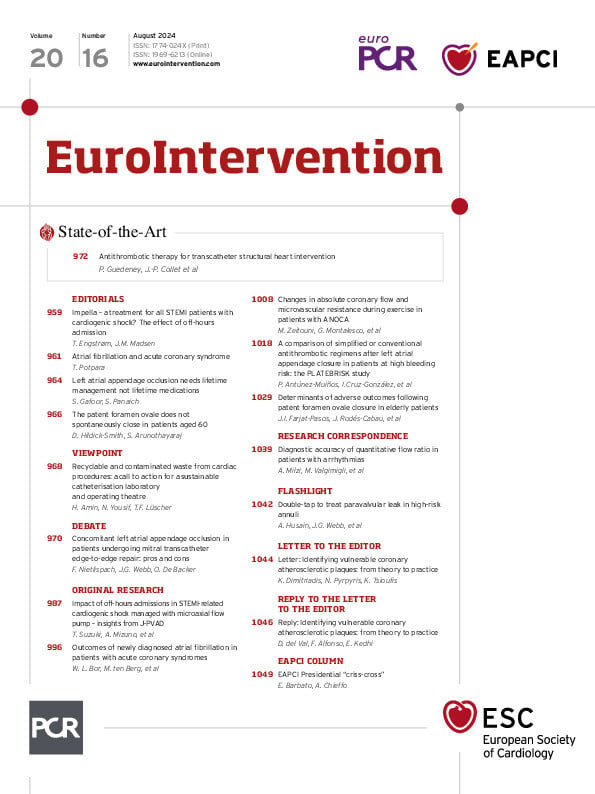Patent foramen ovale (PFO) closure for the prevention of recurrent stroke has travelled a long and winding road to acceptance. The first report of paradoxical embolism through a PFO was published in 1877, but it was not until the 1980s that PFOs were noted to be much more common in the setting of cryptogenic stroke1. Early randomised trials of PFO closure were disappointing – largely because the treatment was available outside clinical trials, and therefore, higher-risk patients were often offered PFO closure and only lower-risk individuals were randomised. More recent trials, however, with increased patient numbers and longer follow-up, have demonstrated the safety and efficacy of PFO closure for the prevention of recurrent stroke2.
PFO closure reduces the risk of stroke by preventing transit of venous thrombus. The clinical trials, aiming for clean data, restricted entrants to those under the age of 60. This strategy was vindicated when the trials were finally positive but has resulted in the disenfranchisement of patients over 60 with likely PFO-related stroke3. Funding bodies, possibly alarmed by the sheer prevalence of PFO, have largely restricted funding to the exact patient types that were recruited into the randomised trials. They cannot be especially criticised for this, as all too often we extrapolate results of trials to patients beyond reasonable parameters, but there is no doubt that if a PFO can be a conduit for venous debris in patients under the age of 60, given that PFOs do not spontaneously close at this age, a PFO must therefore remain a potential conduit for venous debris in patients above the age of 60. Observational data do show that the association between PFO and stroke risk increases with age4. Indeed, as most strokes occur in older patients, PFO closure in this population may even be more effective than in younger patients, as was suggested in the small substudy of >60-year-old patients in the DEFENSE-PFO trial5. Proving the case for older patients is a challenge, however, because of competing risk factors such as atrial fibrillation (AF), large vessel atheroma and hypertension.
The international observational study reported in this edition of EuroIntervention is therefore very welcome6. In this study, Farjat-Pasos et al report on PFO closure in 689 patients aged over 60 from 14 international centres. At a median follow-up of 2 years, recurrent cerebrovascular events in these selected patients occurred at a rate of 1.2 per 100 patient-years. This compared favourably with the expected rate of 3.3 in this population4. Atrial septal “aneurysm” was also associated with increased risk.
Causation of stroke is rarely absolute and rests on probabilities. Tools such as the risk of paradoxical embolism (RoPE) score can quantify the likelihood of PFO-related stroke, but this highly age-based score focuses on the absence of cardiovascular risk factors and does not consider the presence of risk factors that encourage paradoxical embolisation. It is therefore particularly unhelpful in older patients, and actually of little practical use in individual younger patients, though often quoted.
As patients age, the risk of venous thrombosis increases exponentially, due to increasing immobility, operations (especially orthopaedic), blood rheology and pacemaker leads7. At the same time, conditions favouring right-to-left shunting through a PFO increase with age, such as obstructive sleep apnoea, pulmonary hypertension and tricuspid regurgitation (often flowing directly onto the atrial septum). Finally, PFOs have been described to enlarge with ageing8, increasing the likelihood of thrombus transit. Therefore, it is plausible, indeed likely, that PFO-attributable risk actually increases with age – it is just harder to be certain of stroke pathophysiology than it often is in younger patients.
Given that PFO closure is not a complex procedure, and offers lifelong protection from paradoxical embolisation, it may be that in time it will become routine in patients with stroke of a non-specific cause. After all, we treat hypercholesterolaemia, hypertension and diabetes irrespective of whether these are considered directly causative. In this study population, the mean RoPE score was 4.5, indicating a relative absence of patients with multiple vascular risk factors. Less than 3% of patients had a prior diagnosis of AF. Stroke workup was rigorous, with intracranial imaging, carotid Doppler ultrasound, transoesophageal echocardiography and at least 24 hours of Holter monitoring. Finally, patients tended to have anatomically higher-risk PFOs, with atrial septal aneurysm in 61% – incidentally, is it not time we renamed it “floppy” or “mobile” atrial septum to prevent unnecessary patient anxiety?
What this study shows, therefore, is that with careful assessment and appropriate selection, older patients with probable PFO-related stroke can be effectively treated with PFO closure. Compared to therapeutic interventions, prophylactic procedures need a near absence of significant complications, as these would negate any benefits of intervention. The data from this study are relatively reassuring – procedural AF occurred in 1.2% and major complications in 1.4% – still higher than ideal for a preventative procedure.
The absence of direct evidence for PFO closure in older patients should not be interpreted as evidence of absence of efficacy. The ongoing CLOSE-2 (ClinicalTrials.gov: NCT05387954) and STOP (ClinicalTrials.gov: NCT05907694) trials, comparing medical treatment versus PFO closure in patients older than 60 years with cryptogenic stroke are eagerly awaited. Until then, the study by Farjat-Pasos et al shows that PFO closure can be undertaken with good safety and efficacy in carefully selected patients over the age of 60. At the moment, many patients aged 60 with PFO-related stroke are being denied effective “mechanical vaccination”9. This needs to change.
Conflict of interest statement
The authors have no conflicts of interest to declare.

